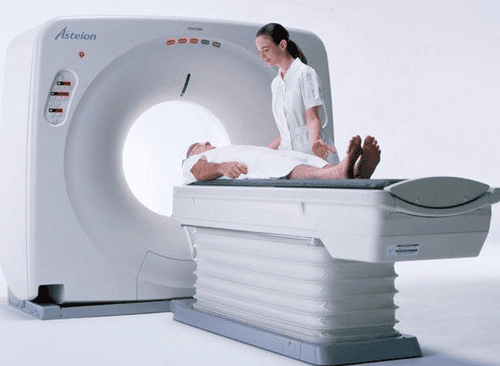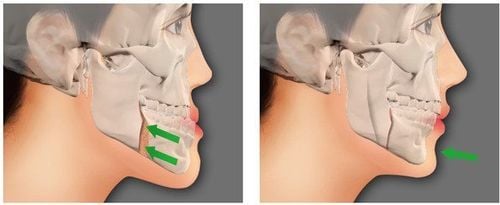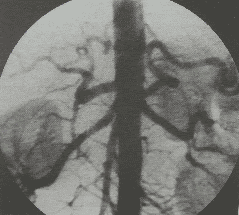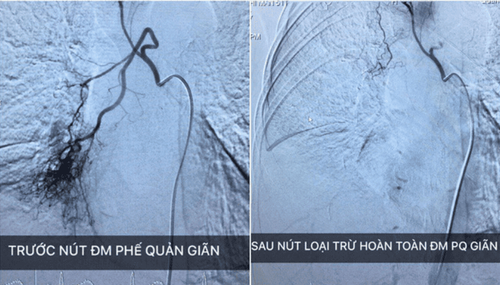This is an automatically translated article.
The article was written by Doctor of Radiology, Department of Diagnostic Imaging - Vinmec Central Park International General Hospital.Arteriovenous malformation imaging and buttoning by digitizing software to erase the background is a modern technique, specifically applied in the diagnosis of malformed blood vessels through light adjustment techniques combined with interventional measures. Cardboard malformed circuit.
1. What is arteriovenous malformation imaging technique and software background erasing software?
Arteriovenous Malformations (AVM) is an abnormal cluster of blood vessels (direct circulation between arteries and veins without passing through capillaries), messy arrangement and easy bleeding. The malformation causes the loss of metabolic capacity in the surrounding tissues, causing bleeding, most commonly gastrointestinal bleeding.Arteriovenous malformation and node digitization software remove background (DSA) to detect bleeding site, combined with the use of invasive treatment of arteriovenous nodule to stop bleeding.
The basic principle of the DSA imaging system is to use fluorescent light and X-ray angiography in the areas to be examined before and after the injection of contrast material into the blood vessels to be imaged. The computer will blur the background image to clarify the vascular system.
2. Indications and contraindications
2.1 Indications Software arteriovenous malformations with complications of pain and bleeding Software arteriovenous malformations have the phenomenon of "stealing blood" of internal organs. 2.2 Contraindications Allergy to Iodine Contrasts Severe renal failure (grade IV) Severe coagulopathy (prothrombin < 60%, INR > 1.5, platelet count < 50 G/L). Pregnant women.
Phụ nữ mang thai có chống chỉ định với kỹ thuật này
3. Preparing for the capture and node of arteriovenous malformation software to digitize background erasure
3.1 Person performing surgery Primary specialist Assistant physician Radiology technician Nurse Doctor and anesthesiologist (if patient is unable to cooperate). 3.2 Media Digital background eraser angiogram (DSA) Electric pump Film, film printer, image storage system Lead vest, apron for X-ray protection. 3.3 Drugs for local anesthetics General anesthetics (if anesthesia is indicated) Anticoagulants Anticoagulants neutralizers Anticoagulants water-soluble iodinated contrast agents Skin and mucosal antiseptic solutions. 3.4 Medical supplies Syringes 1, 3, 5, 10ml Distilled water or physiological saline Gloves, gowns, caps, masks for surgeons Aseptic intervention kit: Knife, scissors, forceps, 4 metal bowls, bean trays, trays for instruments Cotton, gauze and surgical tapes Medicine box, emergency equipment for contrast drugs In addition, there are also specific medical materials such as:Aspiration needles Circuit Board 5-6 F Catheter Standard Lead 0.035-inch, Micro-conductor 0.014-0.018-inch Angiocardiogram 4-5 F, Guide Catheter 6 F, Microcatheter 2-3 F Medicine Materials that cause embolism Bio-foam (gelfoam), bio-glue (Histoacryl, Onyx...) Synthetic plastic beads (PVA) Metal spirals of different sizes 3.5 Patient The procedure is fully explained to the patient. . Patients need to fast, drink water before 6 hours, drink no more than 50ml of water. When coming to the intervention room, the patient was instructed to lie on his back, fitted with a monitor to monitor breathing, pulse, blood pressure, electrocardiogram, and SpO2. The next step is to disinfect the skin, then cover with a sterile cloth with holes. Use sedatives for overstimulated patients who do not lie still.

Người bệnh cần nhịn ăn, uống nước trước 6 giờ, uống không quá 50ml nước
4. Arteriovenous malformation imaging procedure and node digitization software remove the background
4.1 Intravascular access Local anesthesia, skin incision to pave the way into the lumen Use the 21G micro-needle to open arteries and veins Insert the catheter into the vessel. 4.2 Angiography for assessment of lesions Approaches to the foveolar-arterial malformation with catheters and microcatheters Conduct non-selective and selective angiography to assess the hemodynamic status of the malformation. 4.3 Approaching the lesion Approaching the malformation via an arterial, venous or direct puncture When the center of the malformation is accessible, angiography should be performed to confirm the fovea and evaluate assessment of hemodynamic status. 4.4 Embolization Embolization of the malformed fovea with an embolization device Select the appropriate embolization material depending on the arteriovenous access path. 4.5 End of procedure Re-angiogram to check after vascular closure Assess adjacent and downstream branches Close access to vessel lumen. Any questions that need to be answered by a specialist doctor as well as if you want to be examined and treated at Vinmec International General Hospital, you can contact Vinmec Health System nationwide or register online. online on the website.In April & May 2021, when there is a need for examination and treatment of arteriovenous malformations at Vinmec Times City International Hospital and Vinmec Da Nang International General Hospital, customers will enjoy preferential treatment. Double treatment:
- Free specialist examination and free X-ray
- 50% discount on costs for customers with indications for post-examination treatment. The program is limited to the corresponding technique of each hospital and to customers who perform this treatment technique for the first time at Vinmec.
Please dial HOTLINE for more information or register for an appointment HERE. Download MyVinmec app to make appointments faster and to manage your bookings easily.













